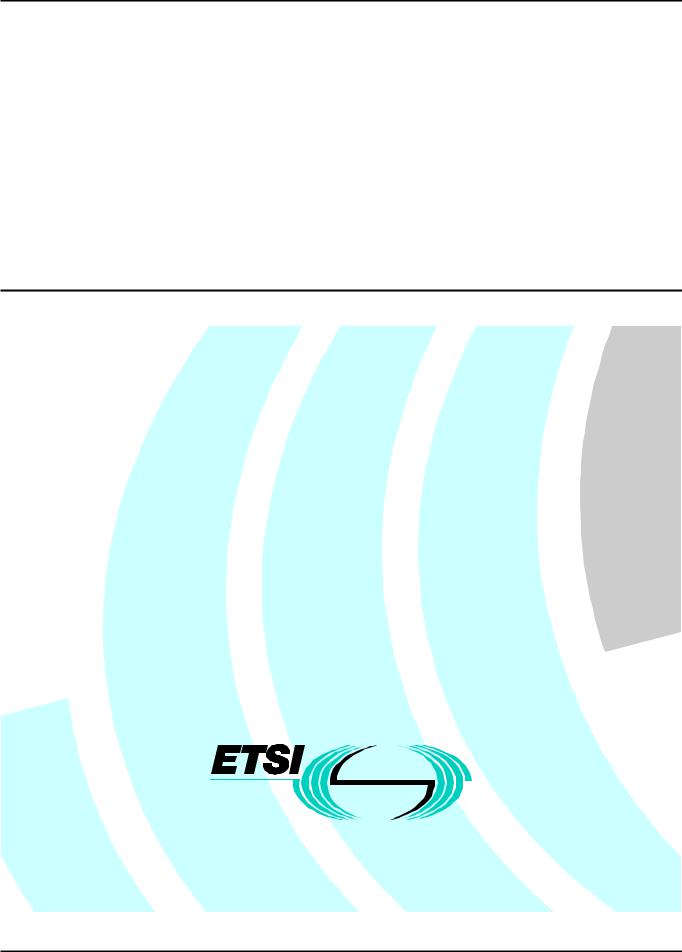
Литература / UMTS-Report
.pdf
TR 101 146 V3.0.0 (1997-12)
Technical Report
Universal Mobile Telecommunications System (UMTS);
UMTS Terrestrial Radio Access (UTRA);
Concept evaluation
(UMTS 30.06 version 3.0.0)
Universal Mobile
Telecommunications System
European Telecommunications Standards Institute

UMTS 30.06 version 3.0.0 |
2 |
TR 101 146 V3.0.0 (1997-12) |
Reference
DTR/SMG-023006U (am001i04.PDF)
Keywords
Access, Air Interface, Radio, UMTS
ETSI Secretariat
Postal address
F-06921 Sophia Antipolis Cedex - FRANCE
Office address
650 Route des Lucioles - Sophia Antipolis Valbonne - FRANCE
Tel.: +33 4 92 94 42 00 Fax: +33 4 93 65 47 16
Siret N° 348 623 562 00017 - NAF 742 C Association à but non lucratif enregistrée à la Sous-Préfecture de Grasse (06) N° 7803/88
X.400
c= fr; a=atlas; p=etsi; s=secretariat
Internet
secretariat@etsi.fr
http://www.etsi.fr
Copyright Notification
No part may be reproduced except as authorized by written permission.
The copyright and the foregoing restriction extend to reproduction in all media.
© European Telecommunications Standards Institute 1997.
All rights reserved.

UMTS 30.06 version 3.0.0 |
3 |
TR 101 146 V3.0.0 (1997-12) |
Contents
Intellectual Property Rights................................................................................................................................ |
4 |
||
Foreword ............................................................................................................................................................ |
|
4 |
|
1 |
Scope ........................................................................................................................................................ |
|
5 |
2 |
References ................................................................................................................................................ |
5 |
|
Annex A: |
Concept Group Alpha α - Wideband Direct-Sequence CDMA ......................................... |
8 |
|
Annex B: |
Concept Group Beta β - Orthogonal Frequency Division Multiple Access |
|
|
|
|
(OFDMA) ............................................................................................................................ |
174 |
Annex C: |
Concept Group Gamma γ - Wideband TDMA (WB-TDMA) ........................................ |
302 |
|
Annex D: |
Concept Group Delta δ - Wideband TDMA/CDMA....................................................... |
486 |
|
History ............................................................................................................................................................ |
|
689 |
|

UMTS 30.06 version 3.0.0 |
4 |
TR 101 146 V3.0.0 (1997-12) |
Intellectual Property Rights
IPRs essential or potentially essential to the present document may have been declared to ETSI. The information pertaining to these essential IPRs, if any, is publicly available for ETSI members and non-members, and can be found in ETR 314: "Intellectual Property Rights (IPRs); Essential, or potentially Essential, IPRs notified to ETSI in respect of ETSI standards", which is available free of charge from the ETSI Secretariat. Latest updates are available on the ETSI Web server (http://www.etsi.fr/ipr).
Pursuant to the ETSI Interim IPR Policy, no investigation, including IPR searches, has been carried out by ETSI. No guarantee can be given as to the existence of other IPRs not referenced in ETR 314 (or the updates on http://www.etsi.fr/ipr) which are, or may be, or may become, essential to the present document.
Foreword
This Technical Report (TR) has been produced by ETSI Special Mobile Group (SMG) of the European Telecommunications Standards Institute (ETSI). This Report has been elaborated by SMG2 "Radio aspects", as part of the evaluation of the Universal Mobile Telecommunications System UMTS Terrestrial Radio Access (UTRA) concepts. SMG2 have not be able to conclude that any single one of these concept provides a better solution than the other concepts.
This Technical Report was prepared during the UTRA evaluation work of SMG2 as a possible basis for the UTRA standard. It is published with the understanding that the full details of the contents have not necessarily been reviewed by, or agreed by, ETSI SMG or SMG2.
NOTE: SMG 2 is responsible for the physical layer of the radio interface and the study of all radio engineering aspects of GSM, DCS 1800 and UMTS,

UMTS 30.06 version 3.0.0 |
5 |
TR 101 146 V3.0.0 (1997-12) |
1 Scope
This document describes the detailed evaluation work towards the definition of the Universal Mobile Telecommunications System UMTS Terrestrial Radio Access (UTRA) within SMG2.
2 References
The documentation for the four concepts compiled in this report may also be found in the following ETSI SMG documentation:
For the α-concept:
-Tdoc SMG 903/97: "System Description Summary";
-Tdoc SMG 904/97: "Evaluation Summary";
-Tdoc SMG 905/97: "Evaluation Report".
For the β-concept:
-Tdoc SMG 894/97: "System Description Summary";
-Tdoc SMG 895/97: "Evaluation Summary";
-Tdoc SMG 896/97: "Evaluation Report".
For the γ-concept
-Tdoc SMG 900/97: "System Description Summary";
-Tdoc SMG 901/97: "Evaluation Summary";
-Tdoc SMG 902/97: "Evaluation Report".
For the δ-concept:
-Tdoc SMG 897/97: "System Description Summary";
-Tdoc SMG 898/97: "Evaluation Summary";
-Tdoc SMG 899/97: "Evaluation Report".
3 Summary of the UTRA definition procedure in SMG2
SMG2’s detailed work towards the definition of the UMTS Terrestrial Radio Access (UTRA) within SMG2 was initiated by a workshop on radio access technologies held December 1996. Since then SMG2 have dealt with UMTS Terrestrial Radio Access at several meetings amongst these 4 SMG2 plenaries, 4 ad-hoc meetings dedicated to UMTS, a joint SMG2-ARIB workshop, a question and answer session and numerous concept group meetings.
In the first step of the process the procedure and time schedule for the UTRA definition was elaborated by SMG2 and agreed by SMG at SMG#21. Hereafter, the requirements impacting the UMTS Terrestrial Radio Access was collected and the high level requirements for the UMTS Terrestrial Radio Access documented and approved by SMG#22. The high level requirements were further detailed in UMTS 21.01.
At the same time UMTS 30.03 describing evaluation criteria for the UTRA definition procedure was elaborated. UMTS 21.01 and UMTS 30.03 were approved by SMG#22. In parallel with the work on these reference documents, SMG2 were collecting technical proposals for radio access technologies for the UMTS Terrestrial Radio Access.
UMTS 30.06 version 3.0.0 |
6 |
TR 101 146 V3.0.0 (1997-12) |
These proposals grouped into the following five concepts:
α -concept based on wideband CDMA (WCDMA)
β -concept based on OFDMA
γ -concept based on wideband TDMA (WB-TDMA)
δ -concept based on TDMA with spreading (WB TDMA/CDMA)
ε -concept based on ODMA (Opportunity Driven Multiple Access)
This grouping was presented to SMG#22 for approval. Hereafter, SMG2 formed five concept groups to assist in evaluation of the different building blocks suggested. Through the period since SMG#22 detailed evaluation of the proposals have been performed and the different original proposals combined into one single proposal for UMTS Terrestrial Radio Access per concept group. Originally the intention was then to merge the concepts into one single concept for the UMTS Terrestrial Radio Access. Unfortunately, SMG2 have failed in doing so.
This leaves a situation where the concepts have been refined and their performance been evaluated in detail. Results of link level and system level results have been discussed within SMG2. Further the SMG2 have checked the different concept against the high level requirements. In general it can be said that the concepts can be claimed to fulfil the high level requirements. However, it should be noted that the area of private and residential operation and the use of unpaired spectrum are not areas on which the concept groups have placed the highest attention. Therefore the issue of UMTS deployment of private and residential operation will require further studies in SMG2 to ensure that the requirements in this area are properly met. The issue of how UMTS can be implemented to enable an operator to make the most effective use of the unpaired spectrum, has not been fully addressed and will require further studies in SMG2.
In particular it may be necessary to consider modification of any adopted UMTS Terrestrial Radio Access concept to improve these aspects of performance.
Regarding the results of the evaluation and refinement work performed, SMG2 has informed SMG about the following findings and conclusions regarding the epsilon concept (ODMA - Opportunity Driven Multiple Access):
-Investigation of relay systems has been carried out within the SMG2 considering the technology called Opportunity Driven Multiple Access – ODMA. The protocols used in ODMA are very similar to those of a packet radio system currently being trialed. System level simulations were carried out in accordance with UMTS 30.03 which showed that wide area high data rate coverage was possible in all environments using a subscriber relay system and that there was potential for increased capacity when used in a cellular hybrid.
-Feasibility studies were conducted to determine the practicality of supporting relaying using the basic WCDMA and WB TDMA/CDMA designs. The conclusion was that both the WCDMA and the WB TDMA/CDMA designs were sufficiently flexible to support relaying with negligible increase to the mobile station complexity or cost. These technologies can therefore offer the flexibility of simple relaying but also provide a suitable platform for advanced relay protocols such as ODMA.
-For the above reasons it was decided that relaying/ODMA should be presented as an enhancement to both WCDMA and WB TDMA/CDMA rather than as a standalone technology. As a result documentation from the studies of epsilon concept is included as a part of the evaluation reports on the alpha and delta concepts.
Regarding the four other concepts (α, β, γ, δ) SMG2 has not been able to obtain any further merging. Moreover, when the uncertainty on simulations and the differences in the assumptions made in order to evaluate that performance of the concepts are considered SMG2 has not be able to conclude that any single one of these concept provides a better solution than the other concepts.
UMTS 30.06 version 3.0.0 |
7 |
TR 101 146 V3.0.0 (1997-12) |
Therefore SMG2 requested SMG to decide on the basis of which of the concepts α, β, γ, or δ SMG2 shall continue the work on the UMTS Terrestrial Radio Access. In order to assist SMG in making the decision SMG2 has prepared the following documentation for each of the concepts:
-A summary of system description for the concept
-A summary of the concept evaluation for the concept
-An evaluation report for the concept
It should be noted that SMG2 does not recommend SMG to make a direct comparison of the performance results for concept based directly on the values contained in the evaluation documentation. This due to the different nature of the concepts, which has lead to differences in the assumptions for the performance evaluation, which lead to differences in the results. Especially regarding guard bands SMG2 would like to highlight, that it is difficult to perform a direct comparison of Minimum Coupling Loss (MCL) based guard band analysis, as, e.g., the likelihood for different scenarios might be different for the different concepts.
SMG2 has not been able to reach a consensus on how the results of the evaluation should be compared, and is therefore unlikely to be able to reach a consensus on the technology for UMTS Terrestrial Radio Access in the foreseeable future. SMG2 therefore recommended to SMG that the best way forward for the elaboration of the UMTS radio interface would be for SMG to make a decision on one concept that should be used by SMG2 in the refinement phase.
It is the understanding of SMG2 that by deciding to base the UMTS Terrestrial Radio Access on a given concept, SMG approves the summary of the system description for that concept. This means that the further refinement of the selected concept is done with reference hereto. Meaning that changes in order to improve the concept shall be justified relative to the concept described in the summary system description.

UMTS 30.06 version 3.0.0 |
8 |
TR 101 146 V3.0.0 (1997-12) |
Annex A:
Concept Group Alpha α - Wideband Direct-Sequence
CDMA
This report contained in this annex was prepared during the evaluation work of SMG2 as a possible basis for the UTRA standard. It is published on the understanding that the full details of the contents have not necessarily been reviewed by, or agreed by, ETSI SMG or SMG2.
UMTS 30.06 version 3.0.0 |
9 |
TR 101 146 V3.0.0 (1997-12) |
ETSI SMG#24 |
TDoc SMG 903 / 97 |
Madrid, Spain |
Agenda item 4.1: UTRA |
December 15-19, 1997 |
|
Source: SMG2 |
|
Concept Group Alpha -
Wideband Direct-Sequence CDMA:
System Description Summary
UMTS 30.06 version 3.0.0 |
10 |
TR 101 146 V3.0.0 (1997-12) |
Concept Group Alpha -
Wideband Direct-Sequence CDMA
System Description Summary
Introduction
Within the Alpha concept group in SMG2, a UTRA proposal based on wideband direct-sequence CDMA has been developed. The WCDMA concept is described in the Alpha group’s evaluation document (Tdoc SMG2 359/97), that contains a system description section. This document presents a summary of the WCDMA system description.
The WCDMA system includes:
∙Wideband CDMA carrier to offer a high degree of frequency diversity and high bit-rates
∙Flexible physical layer for implementation of UMTS services, with support for large range of varying bit-rates with high granularity
∙Built in support for co-existence and efficient handovers with GSM
∙Feasible implementation from day one of UMTS, with possibility for performance enhancement using more demanding features like adaptive antennas and multi-user detection in the future
Key technical characteristics of the basic system
Table 1 below summarises the key technical characteristics of the WCDMA radio-interface.
Multiple-access scheme |
DS-CDMA |
|
|
Duplex scheme |
FDD / TDD |
|
|
Chip rate |
4.096 Mcps (expandable to 8.192 Mcps and 16.384 Mcps) |
|
|
Carrier spacing (4.096 Mcps) |
Flexible in the range 4.4-5.2 MHz (200 kHz carrier raster) |
|
|
Frame length |
10 ms |
|
|
Inter-base station synchronisation |
FDD mode: No accurate synchronisation needed |
|
TDD mode: Synchronisation needed |
|
|
Multi-rate/variable-rate scheme |
Variable-spreading factor and multi-code |
|
|
Channel coding scheme |
Convolutional coding (rate 1/2-1/3) |
|
Optional outer Reed-Solomon coding (rate 4/5) |
|
|
Packet access |
Dual mode (common and dedicated channel) |
|
|
Table 1. WCDMA key technical characteristics.
